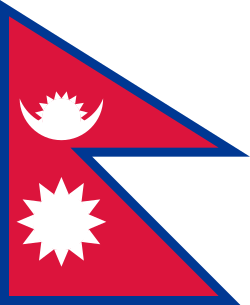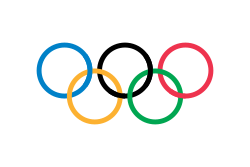Nepal i olympiska sommarspelen 2008
| |||||
| Kommitté | Nepals olympiska kommitté | ||||
|---|---|---|---|---|---|
| Olympiska sommarspelen 2008 i Peking | |||||
| Deltagare | 8 deltagare i 5 grenar | ||||
| |||||
| |||||
| Nepal i olympiska sommarspelen | |||||
| 1964 • 1968 • 1972 • 1976 • 1980 • 1984 • 1988 • 1992 • 1996 • 2000 • 2004 • 2008 • 2012 • 2016 • 2020 | |||||
| Nepal i olympiska vinterspelen | |||||
| 2002 • 2006 • 2010 • 2014 • 2018 | |||||
Nepal deltog i de olympiska sommarspelen 2008 som ägde rum i Peking i Kina.[1]
Friidrott
- Huvudartikel: Friidrott vid olympiska sommarspelen 2008
- Förkortningar
- Notera – Placeringar gäller endast den tävlandes eget heat
- Q = Kvalificerade sig till nästa omgång via placering
- q = Kvalificerade sig på tid eller, i fältgrenarna, på placering utan att ha nått kvalgränsen
- NR = Nationellt rekord
- N/A = Omgången inte möjlig i grenen
- Bye = Idrottaren behövde inte delta i omgången
- Herrar
- Bana och väg
| Idrottare | Gren | Final | |
|---|---|---|---|
| Resultat | Placering | ||
| Arjun Kumar Basnet | Maraton | 2:23:09 | 45 |
- Damer
- Bana och väg
| Idrottare | Gren | Heat | Semifinal | Final | |||||
|---|---|---|---|---|---|---|---|---|---|
| Resultat | Placering | Resultat | Placering | Resultat | Placering | ||||
| Chandra Kala Thapa | 100 m | 13.15 | 9 | Gick inte vidare | |||||
Judo
- Damer
| Idrottare | Gren | Sextondelsfinal | Åttondelsfinal | Kvartsfinal | Semifinal | Återkval 1 | Återkval 2 | Återkval 3 | Final / BM | |
|---|---|---|---|---|---|---|---|---|---|---|
| Motståndare Resultat | Motståndare Resultat | Motståndare Resultat | Motståndare Resultat | Motståndare Resultat | Motståndare Resultat | Motståndare Resultat | Motståndare Resultat | Placering | ||
| Devu Thapa | Halv mellanvikt (-63 kg) | BYE | L 0000–1000 | Gick inte vidare | ||||||
Simning
- Huvudartikel: Simning vid olympiska sommarspelen 2008
Skytte
- Huvudartikel: Skytte vid olympiska sommarspelen 2008
Taekwondo
| Idrottare | Gren | Åttondelsfinaler | Kvartsfinaler | Semifinaer | Återkval | Bronsmatch | Final | |
|---|---|---|---|---|---|---|---|---|
| Motståndare Resultat | Motståndare Resultat | Motståndare Resultat | Motståndare Resultat | Motståndare Resultat | Motståndare Resultat | Placering | ||
| Deepak Bista | Herrarnas −80 kg | L 0–7 | Gick inte vidare | L 2–6 | Gick inte vidare | |||
Tyngdlyftning
- Huvudartikel: Tyngdlyftning vid olympiska sommarspelen 2008
Referenser
- ^ http://www.sports-reference.com/olympics/countries/NEP/summer/2008/ Arkiverad 16 december 2012 hämtat från the Wayback Machine. Sports-reference.com (engelska)
| ||||||||||
Media som används på denna webbplats
Chinese Taipei Olympic Flag. According to the official website of Chinese Taipei Olympic Committee, Blue Sky(circle) & White Sun(triangles) above the Olympic rings is neither the National Emblem of the Republic of China, nor the Party Emblem of Kuomintang (KMT), but a design in between, where the triangles do not extend to the edge of the blue circle, as registered at International Olympic Committee in 1981 and digitally rendered in 2013. Besides, the blue outline of the five-petaled plum blossom is broader than the red one. Moreover, the CMYK code of the blue one and the Blue Sky & White Sun is "C100-M100-Y0-K0", and different from the Olympic rings (C100-M25-Y0-K0). Note that it's the only version recognized by IOC.
Flag of Iran. The tricolor flag was introduced in 1906, but after the Islamic Revolution of 1979 the Arabic words 'Allahu akbar' ('God is great'), written in the Kufic script of the Qur'an and repeated 22 times, were added to the red and green strips where they border the white central strip and in the middle is the emblem of Iran (which is a stylized Persian alphabet of the Arabic word Allah ("God")).
The official ISIRI standard (translation at FotW) gives two slightly different methods of construction for the flag: a compass-and-straightedge construction used for File:Flag of Iran (official).svg, and a "simplified" construction sheet with rational numbers used for this file.
Olympic Movement flag
Proportions 2:3, created 1913, adopted 1914, first used 1920.
- Colors as per http://fairspielen.de/wp-content/uploads/2015/09/Annexe-3-Olympism_and_the_Olympic_Symbol_-_Principles_and_Usages_Guide-1.pdf
- blue: PMS 3005C
- yellow: PMS 137C
- black: PMS 426C
- green: PMS 355C
- red: PMS 192C
- Dimensions of the rings taken from http://fairspielen.de/wp-content/uploads/2015/09/Annexe-3-Olympism_and_the_Olympic_Symbol_-_Principles_and_Usages_Guide-1.pdf






